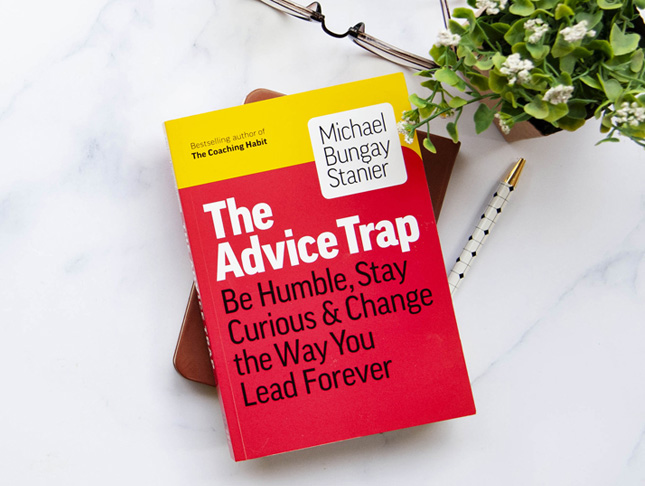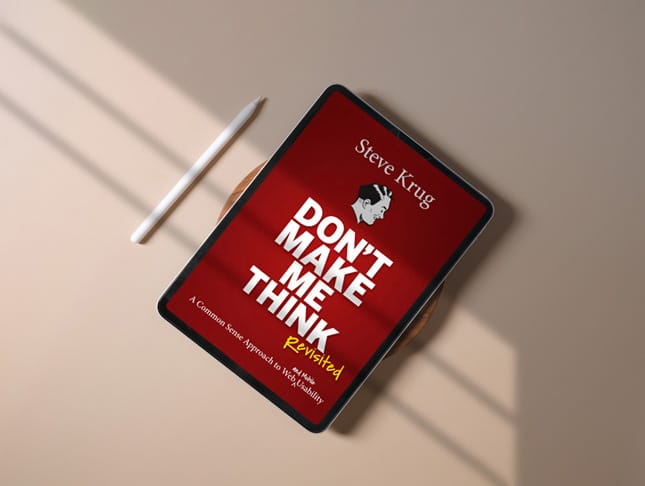Insights on expertise from 'The Business of Expertise' by David C. Baker
Book review and summary

Last modified
Who this book is for: Entrepreneurs, business owners, professionals who works with clients in an advisory role
Publication date: 2017
Publisher: Rockbench Publishing
Number of pages: 233
Where to buy: Amazon
About the author
David C. Baker is an author, speaker and advisor to entrepreneurial experts – he is frequently referred to as the "expert’s expert". His work has been featured in the Wall Street Journal, New York Times, Fast Company, Inc Magazine and Forbes.
Overview
In a style both lively and irreverent, David C. Baker unpacks what it means to be a purveyor of expertise and how entrepreneurial experts convert their insight into impact and wealth.
Summary
The book explores the following core concepts:
1. Pattern matching is the foundation to expertise
2. Good positioning renders your work less interchangeable
3. Saying “no” is an important skill
4. You need to become a “T-shaped” expert
5. Constantly share your expertise through your writing
1. Pattern matching is the foundation to expertise
Pattern matching – or the ability to see relationships and connections between data sets where others see only noise – is the basis of expertise. This is a process honed through extreme focus, discipline and smart positioning. When consultants specialize in a narrow field of expertise (such as a specific vertical), they start to see patterns emerging which give them the edge in delivering meaningful, actionable insights to their clients. In this way, expertise flows naturally from positioning.
2. Good positioning renders your work less interchangeable
Smart positioning is foundational to expertise. This positioning might take the form of vertical specialization (e.g. focusing on a specific industry of clients) or horizontal niching (e.g. focusing on demographic or psychographic client factors). Here are examples of both approaches:
| Positioning | Examples |
| Vertical positioning |
- Consulting to consumer beverage companies |
| Horizontal positioning |
- Consulting CEOs in managing change in disruptive environments |
Over time, tight positioning leads to greater impact for clients (due to enhanced pattern matching abilities, discussed above) and better financial performance for the expert. The smaller your firm, the more important positioning becomes as it gives you an edge compared to larger competitors with deeper benches.
Baker recommends fine-tuning your company’s positioning strategy every five years, and exploring tighter positioning over time (for example, by combining vertical and horizontal factors to become even more focused).
An expert is one who knows more and more about less and less.”
– Nicholas Murray Butler, Columbia University
3. Saying “no” is an important skill
A crucial component of positioning is working with right-fit clients. The focus of an expertise-driven practice should be less on company growth and more on impact achieved and profitability. This approach minimizes risks for the firm. Baker recommends sizing your firm’s capacity to be slightly smaller than the opportunity within reach to allow you to pick and choose your clients and projects, while maintaining price integrity in the process.
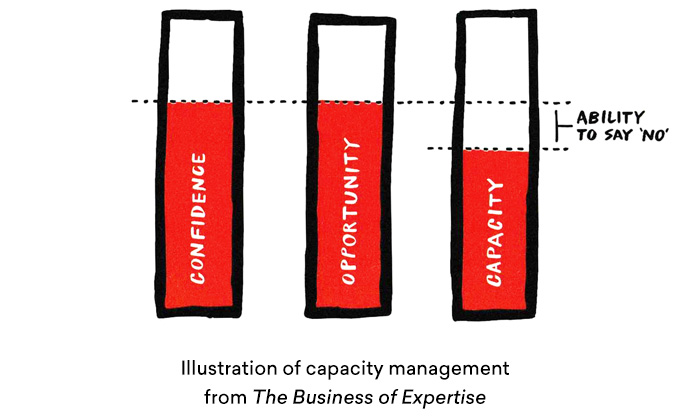
The difference between successful people and really successful people is that really successful people say no to almost everything."
– Warren Buffett
4. You need to become a “T-shaped” expert
Successful consultants need to develop “T-shaped” expertise according to Baker – this means nurturing deep subject matter expertise in your chosen field, while maintaining a light level of learning in adjacent fields of knowledge. This concept is similar to that of the T-shaped marketer, where a user experience expert, for example, might stay up-to-date with trends in social media marketing, content marketing and SEO, while investing in deep knowledge immersion in the field of UX.
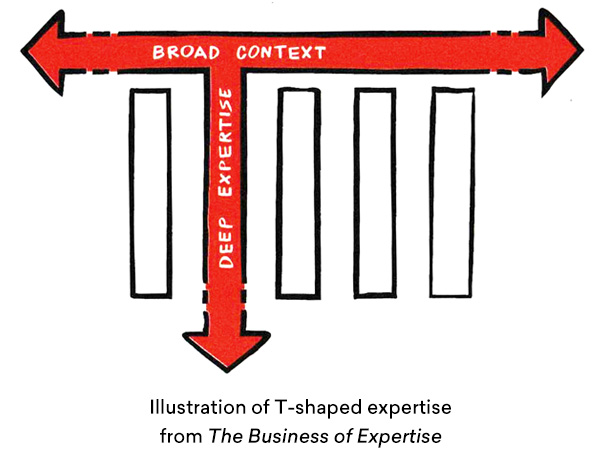
In addition to honing your professional craft, Baker recommends maintaining a varied, sponge-like personal life (which includes activities such as traveling globally and reading widely) to put that expertise into context.
Ana Wintour recommends a similar strategy in her Masterclass on Creative Leadership, where she proposes that creatives make a point of meeting new people regularly, traveling to new places, consuming a wide variety of art forms and hearing opposing ideas on a variety of subject matters as part of continuous professional development.
5. Constantly share your expertise through your writing
Lastly, Baker recommends that experts regularly articulate what they notice through their writing. The process of writing about what you are learning not only positions you as an authority in your field, but also helps you achieve greater precision in your thinking. Put differently, clarity follows articulation.
I write entirely to find out what I’m thinking.”
– Joan Didion
As an aside, sharing what you know will also contribute to the success of your firm’s overall content strategy.
Conclusion
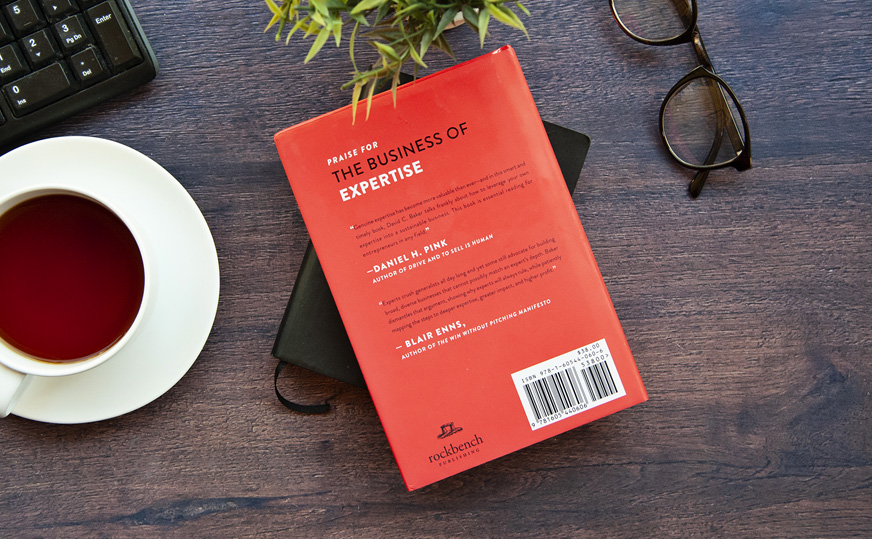
The Business of Expertise is a compact but thought-provoking read filled with insights and anecdotes – on client management, positioning and professional development – that vendors in the professional services field will find engaging and relatable.
For those wishing to dive deeper, here is a full list of chapters covered:
- The role of expertise in a developed society
- The interplay between expertise and fulfillment
- The why for your entrepreneurial expertise
- Combining expertise and entrepreneurship
- The relevance and sustainability of expertise
- Positioning mistakes and why we make them
- Practicing expertise within a broader context
- Distinguishing between vertical and horizontal expertise
- Principles of the less exchangeable positioning of expertise
- Distinguishing expertise from implementation
- Five early tests for the positioning of your expertise
- Four later tests for the positioning of your expertise
- Demonstrating expertise
- Not demonstrating expertise
- How expertise unfolds: a recap
- The long game: maintaining relevant expertise

We specialize in web services for professional services firms. Browse our case studies below for examples of our work.

